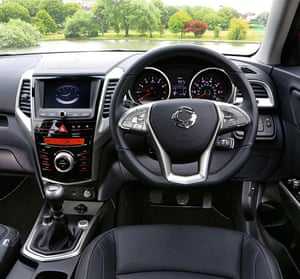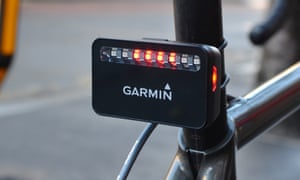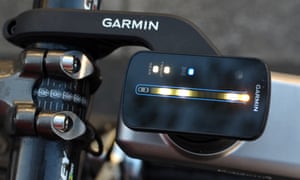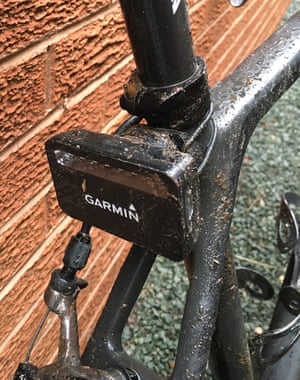On the road: Ssangyong Tivoli – <b>car review</b> | Technology | The <b>...</b> |
- On the road: Ssangyong Tivoli – <b>car review</b> | Technology | The <b>...</b>
- Skoda Superb estate: <b>car review</b> | Martin Love | Technology | The <b>...</b>
- Garmin Varia Rearview Radar <b>review</b>: bike light that shows when <b>...</b>
| On the road: Ssangyong Tivoli – <b>car review</b> | Technology | The <b>...</b> Posted: 27 Nov 2015 10:00 PM PST This is the new way of things, I start to realise: cars that are cute like Minis or Beetles, but the size of something larger. Such a car – my first encounter was the Fiat 500X, now it's Korean brand Ssangyong's Tivoli – may discombobulate you for a while. You think you're in a city runabout, and you're not. If you have a very visual imagination, you might crash it a few times. Then one day, you'll be used to it. The Tivoli is a relentlessly cheerful car, not only because it is flaming red (their description; not my archaic swearing). Its demeanour is bouncy, despite its square, bossy nose and trad interior. There's a lot of zing in the middle gears; in third, it holds its speed and responds smartly. It's always ready with a bit more push than you expect, and sometimes feels a bit like flying. It has neither a wild top speed – 107mph – nor a particularly impressive zero to 62mph – 12 seconds – but it feels like it should have: passengers, especially young, stupid ones, were constantly asking me to floor it. It is more fun in the city than on a motorway; the handling is fine but a bit monotonous, and the ride isn't completely smooth. That said, acceleration was never any bother and if it was a little bit whiny in sixth, well, aren't we all? The screen, binnacles and steering wheel controls all look as though they belong to a more expensive car. It has a stick parking brake, which I prefer by far to the newfangled button arrangement, while the engine goes on with a start-stop button, which I prefer to sticking a key in a hole. The satnav is a bit of a pest – verbose, pedantic, not very responsive. There are also far too many alarms – an overanxious lane discipline beep, melodramatic front and rear parking noises, constant fussing about speed and seat belts. It's like having a back-seat driver built into the car, which itself is like getting a kettle which has been pre-limescaled. But I only say all of that the way you would complain about a person who was basically cool but sometimes a little bit loud: it is the only Ssangyong you would ever buy for emotional reasons – the others are all big, boxy and characterless. Related: On the road: Bobbin Brownie – bike review My worry is that it's a bit like one of those splashy, toothsome indie songs: you absolutely love it, then one day you wake up and absolutely hate it (specifically, I'm thinking of I'm Glad I Hitched My Apple Wagon To Your Star). But even if you do fall out of love, unlike an indie song, you will be left with considerable practical and thrifty benefit.
Price £17,250 • This article was amended on 1 December 2015 to correct a brake/break homophone. |
| Skoda Superb estate: <b>car review</b> | Martin Love | Technology | The <b>...</b> Posted: 28 Nov 2015 10:00 PM PST Price: from £19,785 "What's the best car you've driven?" It's a question I am often asked and I know the answer I am supposed to give. Something like: "Oh, that DBS from Casino Royale wasn't too bad" or "Well, the 1956 Le Mans D-Type, now valued at £3m, was pretty cool…" And yes, these are truly extraordinary cars to drive. But they are not cars you can actually use in the ordinary sense of, you know, a car… So, to stir things up, I like to say: "It's a Skoda!" I pause for the baffled head shake and then I add: "Actually, it's the Skoda Superb estate." It's fun winding people up, but it is also true. Since 2001, when Skoda first introduced its Superb, the Czech firm's flagship model has been a shopwindow for the company's huge strides in quality, safety, economy and comfort. It's been blanketed in good reviews and endless gongs, some quite unexpected – last year, for instance, it was named the UK's Luxury Car of the Year. A Skoda! Who knew? There are still a few benighted souls out there who think Skodas are a joke, but not many. And with the launch of this third-generation Superb, the only people now laughing will be Skoda. This Superb is the firm's most sophisticated car ever. It's been designed to offer the refinement of a large car, but with canny Skoda value thrown in, too. For me, the estate version is all the family car a family could possibly want. It's an aesthetic mix of crisp lines and sharp creases. The fold which runs the length of the car, from front lens to rear lamp, gives it poise and purpose. Step in and you are immediately impressed by the quality of materials. And it feels enormous – the space between front and back seats is limo-like. That "knee gap", in fact, is so large it's become the Superb's calling card. The car is brimming with pleasing touches – they call them "surprise and delight" details in the industry. There's an umbrella concealed in the door, for instance, and an ice scraper hidden in the petrol cap. And all necessary driver aids are present and correct, from adaptive cruise control to park assist. There's a range of petrol and diesel engines on offer; the most efficient is the 1.6 TDI, which does an overdraft-soothing 76.4 miles to the gallon – well, as much as we can believe figures these days. To drive it is, as the name suggests, superb: smooth, eager, unfailing. Miles evaporate more quickly than sanity at a 14-year-old's birthday party. Believe me, we've just had one. But, and this is why it's the best car I've driven, within seconds of sitting at the wheel you feel it has been built with you in mind. It feels as if it's been made just for you. And you can't say that about a James Bond car… Email Martin at martin.love@observer.co.uk or follow him on Twitter at@MartinLove166 |
| Garmin Varia Rearview Radar <b>review</b>: bike light that shows when <b>...</b> Posted: 29 Nov 2015 11:00 PM PST The rear light with built-in radar gets brighter the closer a car gets, while showing you how far away they are on a small handlebar-mounted display. Photograph: Samuel Gibbs for the Guardian The Garmin Varia Rearview Radar is a smart rear bike light that aims to improve your visibility, situational awareness and safety with adaptive brightness and a radar display. It's a rear bike light with built-in radar, which tells you when a car is approaching by showing the vehicle's position on a handlebar-mounted display. It detects cars from up to 140m away and can track up to eight separate vehicles at once. It's not the prettiest light, looking very similar to iKubu's crowdfunded Backtracker. The company was bought by Garmin and brought to market. Garmin has sharpened up the edges and added integration with the company's top-end Edge cycling computers. Specifications
Setting up
The light is compact measuring 73 x 44 x 23mm. The base mounts to the seatpost by an elastomer band – Garmin's standard system, which is easy to fit or remove and stays put when riding. The light twists into the base mount using Garmin's quarter-turn system. Fitting the light takes about two minutes. Pairing the head unit and rear light, again, takes a couple of minutes. It's quick, easy and works well. At 15 lumens, it's not the brightest light on the market. For comparison the £35 Exposure Flare Rear Light produces 75 lumens and the £40 Lezyne Micro Drive Rear Light produces 70 lumens. It will be fine for most uses around town, but on unlit roads, I would use a secondary light. BlinkenlightsThe supplied radar display is small, showing your position at the top and cars approaching from behind as a run of white LEDs. Here's what happens when it picks up a car approaching and passing:
And from the driver's perspective, the light gets brighter the closer the car gets: More LEDs light the closer the car comes to the rear of the bikeCityv countryIt's safe to assume that in urban environments there's going to be a car following. Checking for vehicles over your shoulder is the order of the day and this isn't a substitute for doing so. It doesn't track cars travelling at the same speed or slower than you, so doesn't display the full situation behind. The biggest problem is that the Varia Radar Display Unit doesn't make any audible signal when cars are approaching; you have to look at the display in order to check for cars. By the time you've heard the car, you already know it's there. It isn't an early warning system, which is how this technology feels best used. Its usefulness is limited to checking how fast the car is approaching once you've heard it. Helpful, but not game changing. The lack of audible alerts for moving cars is even more frustrating when out in the countryside. The unit is excellent at detecting cars before you could have heard them approaching, assuming you're looking down at your handlebars when it does. Which is a bad idea. It's worth noting that it's a different story when the rear light is paired with Garmin's £390 Edge 1000 bike computer which beeps when it detects a car.
Durability Two filthy and wet rides later, it held up fine. It's rated to IPX7 meaning it "withstands incidental exposure to water of up to 1m for up to 30 minutes". Probably not recommended, but I'd be comfortable washing the grime off this with a sponge or under a gently running tap. Battery lifeGarmin states the Varia will last four hours per charge. In my testing I found it lasted longer. Setting off for a ride at 8:30, I received a low battery warning at 13:30, giving it a five-hour run time. It was set to daytime running modelighting two LEDs as standard and brightening when cars pass. It wouldn't last for a winter training ride of more than six hours, so you'll need some other lights if there's a chance you'll be out after dark or on murky winter days. It takes two hours to charge the light, but despite being charged via microUSB it doesn't come with a power adapter. Any smartphone charger or computer USB port will work, but there are two devices to charge, so you'll need to coordinate your charging. Price
The Garmin Varia Rearview Bike Radar is available with and without the front display costing £240 and £160. By comparison the Exposure Flare Rear Light costs £35 and produces 75 lumens while the 70 lumens Lezyne Micro Drive Rear Light costs £40. No other mainstream light has radar functionality. VerdictThe Varia Rearview light is useful, automatically adjusting brightness, but the lack of audible alerts from the radar display when it detects a car is extremely frustrating. You have to look down at your handlebars to spot what's going on, which is distracting when on the road. On country roads it can spot cars before you hear them, but in the city it's less useful, not least because you should be frequently checking over your shoulder for vehicles anyway. On it's own it is flawed. With the Garmin Edge 1000 it's great, but that's another £390.
|
| You are subscribed to email updates from car review - Google Blog Search. To stop receiving these emails, you may unsubscribe now. | Email delivery powered by Google |
| Google Inc., 1600 Amphitheatre Parkway, Mountain View, CA 94043, United States | |





No comments:
Post a Comment